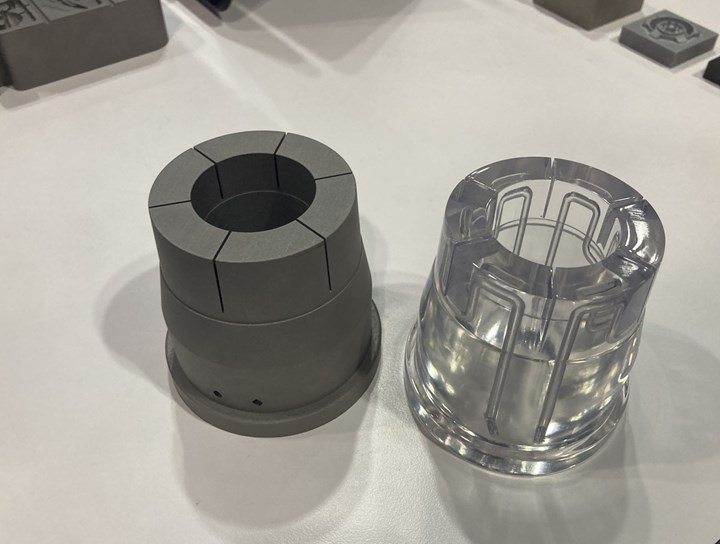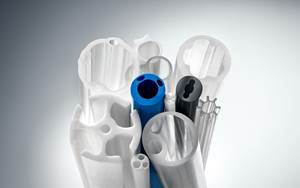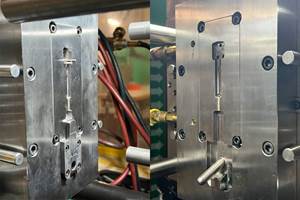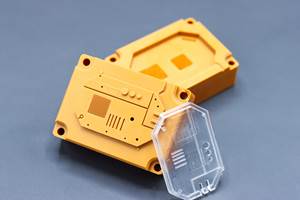Additive Technologies for Injection Mold Tooling Ride Tailwinds
NPE2024: Lowering barriers to additive manufacturing adoption in toolmaking.
At NPE 2024, attendees are getting a look at what advances in additive manufacturing (AM) can do for plastics processors. Products and services are intended to lower the bar to entry by addressing some of the common causes for trepidation in would-be adopters of additive technologies, casting them more as temporary pains than endemic shortcomings.
The promises of moving beyond traditional methods of making injection mold tooling have been well established. AM technologies can remove design constraints, opening up design geometries that would be difficult or impossible to create by other means. These include conformal cooling channels that can reduce cycle time and enable better heat management to reduce warpage.
Historically, barriers have limited the scope of the impact of advances in additive technologies in toolmaking. The cost of equipment has been high, discouraging would-be customers from taking a risk by purchasing something that may be novel to them. A limited selection of materials could be a discouragement. There is a cost associated with training when changing technologies, particularly when the learning curve is sharp.
These barriers have been ameliorated in recent years by changes in the overall marketplace and technological advances. Suppliers of additive equipment, additively manufactured tooling and services are anticipating an inflection point in adoption. “A lot is happening all at once, like a perfect storm,” says Scott Kraemer, application engineer at Xact Metal.
Transitions in the Workforce
People who entered the workforce when manufacturing was at its peak are increasingly leaving it, and naturally there is concern at the loss of their finely honed skills in an area like toolmaking.
“We continue to hear about labor shortages and our ability to automate toolmaking so that your toolmaker is spending 10 hours instead of 100 — or even in some scenarios no hours — people really value that,” says Paul DiLaura, chief commercial officer at Mantle.

Mantle is displaying 3d printed tooling alongside transparent models to show cooling channel design. Source: Matt Stonecash
As companies seek to minimize their exposure to succession risks — and supply chain risks — ease of use can be a selling point. Software development and simplification has reduced the time and training needed for adoption.
Wider Distribution of Price Points
Each successive product generation brings more capability at lower costs. This can be a significant factor in the adoption of a new technology.
“Moldmakers are creatures of habit. For us to go out and drop $500,000 to $800,000 on a technology we don’t fully understand and then try to figure out how to do it and make a profit is a big challenge,” Kraemer says. Today, equipment suppliers are offering customers solutions at price points closer to the range of what a CNC machine might cost.
Wider Selection of Materials
A theme visible across many additive applications is an expansion of the available materials compatible with 3D printing processes, as suppliers and service providers look to meet their customers where they are on material needs and preferences.
Mantle recently announced the qualification of 420 stainless steel paste with its P200 printer. This should be of interest for molders who operate in conditions that accelerate corrosion, especially for those whose molding operation can benefit from the use of conformal cooling channels.
“Cleaning cooling channels is part of the maintenance and upkeep that people do with their molds. There is a concern that a steel will rust over time and make it harder to clean or that you have to clean more frequently. With stainless steel, you don’t have that problem,” DiLaura says.
Xact metal is also aiming to appeal to the corrosion averse, recently adding Corrax tool steel to its offerings through its partnership with Uddeholm. Corrax is described as similar in corrosion resistance to a 300 series SS but the mechanical properties of 400 series.
An Array of Technologies Offer Increased Flexibility
3D printing may be the most recognizable additive technology, but it may not be suited for every application. For example, most printers have a build chamber, capping the size of components that can be printed. “Imagine an application for a car bumper. To print it, it would take ages and the costs would be huge. So other technologies more suitable, in this respect,” says Mario Ivankovic, market reach director of HTS Group. HTS group manufactures molding components using technologies that include direct energy deposition, diffusion bonding, and 3D printing.
Given the diversity of needs in injection molding, it’s unlikely that one product or even one technology will fit all. Scott Kraemer says, “If you look at CNC machining and wire EDM machines, EDM didn’t replace CNC. It’s another tool in your toolbox, to get the job done.”
Related Content
Medical Manufacturer Innovates with Additive Manufacturing and Extrusion Technology Hubs
Spectrum Plastics Group offers customers two technology hubs — one for extrusion, the other for additive manufacturing — to help bring ground-breaking products to market faster.
Read More3D Printing of Injection Molds Flows in a New Direction
Hybrids of additive manufacturing and CNC machining can shorten tooling turnaround times.
Read MoreMake Every Shot Count: Mold Simulation Maximizes Functional Parts From Printed Tooling
If a printed tool only has a finite number of shots in it, why waste any of them on process development?
Read MoreAdditive Fusion Technology Optimizes Composite Structures for Demanding Applications
9T Labs continues to enhance the efficiency of its technology, which produces composite parts with intentionally oriented fibers.
Read MoreRead Next
Lead the Conversation, Change the Conversation
Coverage of single-use plastics can be both misleading and demoralizing. Here are 10 tips for changing the perception of the plastics industry at your company and in your community.
Read MoreMaking the Circular Economy a Reality
Driven by brand owner demands and new worldwide legislation, the entire supply chain is working toward the shift to circularity, with some evidence the circular economy has already begun.
Read MoreSee Recyclers Close the Loop on Trade Show Production Scrap at NPE2024
A collaboration between show organizer PLASTICS, recycler CPR and size reduction experts WEIMA and Conair recovered and recycled all production scrap at NPE2024.
Read More






















